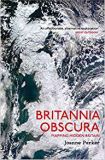Britannia Obscura: Mapping Britain's Hidden Landscapes by Joanne Parker
| Britannia Obscura: Mapping Britain's Hidden Landscapes by Joanne Parker | |
|
| |
| Category: History | |
| Reviewer: John Lloyd | |
| Summary: A brilliant book, in many aspects – just not the book I expected it to be. | |
| Buy? Yes | Borrow? Yes |
| Pages: 224 | Date: November 2015 |
| Publisher: Vintage | |
| External links: Author's website | |
| ISBN: 9781784700003 | |
|
| |
What shape do you assume Britain to be? If you merely go by the current map, you're holding yourself ransom by the secessionists wanting devolution, and changes to the boundaries within Britain, but doesn't the place go beyond that outline on the page? Remember, it used to be connected to mainland Europe, and once we'd sort-of-settled into one kingdom on our shores the people in charge were also ruling over parts of France. And of course – the two-dimensional plan of the British Isles is nowhere near the real story, for we have many coastal waters, we have airspace, and we have a large subterranean territory. You can definitely throw away the imagined space of Britain, for the reality is far grander.
This book is defined as a travel book. It's not. In five lengthy chapters (and happily they're chapters, and not essays) we go through different mapped aspects of Britain, each time spinning off from a cartographer's regular presentation to find something different. We start with the cave networks, and how our picture of them has changed. This has happened mostly through just finding greater, deeper, longer and richer cavernous territories, even in recent years, but also the pattern has been physically altered by manmade interference, knocking out walls of silt and clambering through rockfalls to connect what might have not been united in millennia. This is a ghost Britain that even those tramping round the few underground tourist spots seldom think of.
Another way in which these Britains are not the one you know of is that London hardly appears on the next two maps – that for megalithic Britain and the canal network. It seems a major boundary in our nation's past is defined by the beginning (or end) of stone henges and corridors of standing rocks; perhaps the south-east and east were just too progressive and used wood for their pioneering constructions, which would have made it easier for them to be adapted – Stonehenge is a complete hodge-podge and may have suffered three attempts to 'get it right', if ever it was. The inland waterways, for which we get a completely thorough history, hardly touched on London, even with one of the richest ports in the world, but then a lot of the canal network was actually for shorter trips.
We then turn to a pair of less substantial, but no less interesting, subjects – ones we literally cannot get a grip on. Ley lines are fascinating – alleged paths of power that connect sacred and/or ancient sites, such as Roman hill forts, or mediaeval churches. Was man really following some spiritual feng shui guidelines in the magnetic field when he put what was important to him where it is? Probably not, but the vim and vigour of the telling of the history of this field of research has certainly been energised by something; it's brilliant. Finally we go up to the airways – the routes commercial and military aircraft are beholden to take from A-B. Needless to say London has a presence there…
So what is this book? Like I say, it's not travel. It's history. The rise and fall and rise of canals is expertly portrayed – and while we start looking at one specific instance the author may well have gone to in her research, we see the full gamut of what we need to know to get the bigger picture, and we don't leave our armchairs as such. Yes, she approaches Stonehenge (up to the barriers twenty feet away, of course) but the writing does not convey the travel experience to meet these megaliths – instead it points to a website for people that regularly do just that, and for thousands of much less well known patterns than the Wiltshire classics. The book is more concerned with what it might have meant for a patch of land to have a megalith or henge, and what the megalith got from where it was (which in the case of Salisbury Plain was a lot more populated than it is now). This becomes psychogeography, the way we put landmarks on our world and how they in return affect us.
A small cavil is in those words, however. I was interested in buying this book for someone who loves the whole Roger Deakin style of travelogue, and reading about how the changes mankind put on nature can be explored as a natural part of our history and geography. This does not hit these pages enough. I loved the summary of the history of our understanding of menhirs, henges et al, and of our canals, and it was certainly interesting to see the spelunkers, potholers and so on who know what is under our feet, but the end result of the book was left to me to patch together from the examples given. These are exercises not in mapping mankind, but in mapping just a few aspects of our country. They are oft-neglected sides of our country, but not seen from an angle in which we can engage fully. The historical bent to proceedings should have had more room for us to see ourselves in these places, for they are rich enough to change our individual and collective psychology when we go to them, but I don't think you'd know it from this writing.
Still, before I go into Pseud's Corner (alongside the ley line dowsers) I have to take my hat off to Ms Parker. Fresh from academe she writes superbly, with the lightest of touches to her swathes of research, and her samples of interview are expertly placed on the page. Her explanation of air space, from the first times we encroached it above the UK on, is excellent. But a travel book? Never. This travels back in time perfectly, but it left me with several subjects (and the afterword admits there could be a whole sequel volume if not more of unchosen possibilities) that I hadn't fully engaged with as a Briton, as a person, as an armchair traveller. I'd learnt the background to many things, but was left with no sense of how they felt and feel. I hadn't seen any of the subjects, whether they be intangible air routes or something more substantial. Still, for the history of some esoterically-chosen subjects, this is certainly a substantial read.
I must thank the publishers for my review copy.
Travel and history certainly combine in Mudlark River: Down the Thames with a Victorian Map by Simon Wilcox.
Please share on: ![]() Facebook,
Facebook, ![]() Twitter and
Twitter and
![]() Instagram
Instagram
![]() You can read more book reviews or buy Britannia Obscura: Mapping Britain's Hidden Landscapes by Joanne Parker at Amazon.co.uk Amazon currently charges £2.99 for standard delivery for orders under £20, over which delivery is free. (Paid link)
You can read more book reviews or buy Britannia Obscura: Mapping Britain's Hidden Landscapes by Joanne Parker at Amazon.co.uk Amazon currently charges £2.99 for standard delivery for orders under £20, over which delivery is free. (Paid link)
![]() You can read more book reviews or buy Britannia Obscura: Mapping Britain's Hidden Landscapes by Joanne Parker at Amazon.com. (Paid link)
You can read more book reviews or buy Britannia Obscura: Mapping Britain's Hidden Landscapes by Joanne Parker at Amazon.com. (Paid link)
Comments
Like to comment on this review?
Just send us an email and we'll put the best up on the site.


